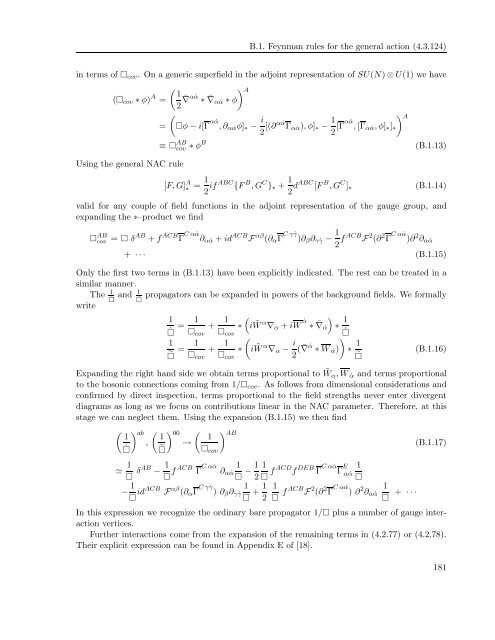Perturbative and non-perturbative infrared behavior of ...
Perturbative and non-perturbative infrared behavior of ...
Perturbative and non-perturbative infrared behavior of ...
Create successful ePaper yourself
Turn your PDF publications into a flip-book with our unique Google optimized e-Paper software.
B.1. Feynman rules for the general action (4.3.124)<br />
in terms <strong>of</strong> cov. On a generic superfield in the adjoint representation <strong>of</strong> SU(N) ⊗ U(1) we have<br />
A 1<br />
(cov ∗ φ) A =<br />
=<br />
2 ¯ ∇ α ˙α ∗ ¯ ∇α ˙α ∗ φ<br />
<br />
φ − i[Γ α ˙α ,∂α ˙αφ]∗ − i<br />
2 [(∂α ˙α Γα ˙α),φ]∗ − 1<br />
2 [Γα ˙α ,[Γα ˙α,φ]∗]∗<br />
≡ AB<br />
cov ∗ φ B<br />
Using the general NAC rule<br />
[F,G] A ∗<br />
= 1<br />
2 ifABC {F B ,G C }∗ + 1<br />
2 dABC [F B ,G C ]∗<br />
A<br />
(B.1.13)<br />
(B.1.14)<br />
valid for any couple <strong>of</strong> field functions in the adjoint representation <strong>of</strong> the gauge group, <strong>and</strong><br />
exp<strong>and</strong>ing the ∗–product we find<br />
AB<br />
cov = δAB + f ACB Γ C α ˙α ∂α ˙α + id ACB F αβ (∂αΓ C γ ˙γ )∂β∂γ ˙γ − 1<br />
2 fACB F 2 (∂ 2 Γ C α ˙α )∂ 2 ∂α ˙α<br />
+ · · · (B.1.15)<br />
Only the first two terms in (B.1.13) have been explicitly indicated. The rest can be treated in a<br />
similar manner.<br />
The 1 ˆ <strong>and</strong> 1 e propagators can be exp<strong>and</strong>ed in powers <strong>of</strong> the background fields. We formally<br />
write<br />
1<br />
ˆ<br />
1<br />
= +<br />
cov<br />
1<br />
cov<br />
1 1<br />
= +<br />
cov<br />
1<br />
∗<br />
cov<br />
<br />
∗<br />
i ˜ W α ∇α + iW ˙α ∗ ¯ ∇ ˙α<br />
<br />
∗ 1<br />
ˆ<br />
<br />
i ˜ W α ∇α − i<br />
2 ( ¯ ∇ ˙α <br />
∗ W ˙α) ∗ 1<br />
<br />
(B.1.16)<br />
Exp<strong>and</strong>ing the right h<strong>and</strong> side we obtain terms proportional to ˜ Wα,W ˙α <strong>and</strong> terms proportional<br />
to the bosonic connections coming from 1/cov. As follows from dimensional considerations <strong>and</strong><br />
confirmed by direct inspection, terms proportional to the field strengths never enter divergent<br />
diagrams as long as we focus on contributions linear in the NAC parameter. Therefore, at this<br />
stage we can neglect them. Using the expansion (B.1.15) we then find<br />
ab 00 AB 1 1 1<br />
, →<br />
ˆ cov<br />
≃ 1<br />
δAB − 1<br />
fACB Γ C α ˙α 1 1 1<br />
∂α ˙α −<br />
2 fACDf DEB Γ C α ˙α Γ E 1<br />
α ˙α<br />
<br />
− 1<br />
idACB F αβ (∂αΓ C γ ˙γ 1 1 1<br />
) ∂β∂γ ˙γ +<br />
2 fACB F 2 (∂ 2 Γ C α ˙α ) ∂ 2 1<br />
∂α ˙α<br />
<br />
+ · · ·<br />
(B.1.17)<br />
In this expression we recognize the ordinary bare propagator 1/ plus a number <strong>of</strong> gauge interaction<br />
vertices.<br />
Further interactions come from the expansion <strong>of</strong> the remaining terms in (4.2.77) or (4.2.78).<br />
Their explicit expression can be found in Appendix E <strong>of</strong> [18].<br />
181
















